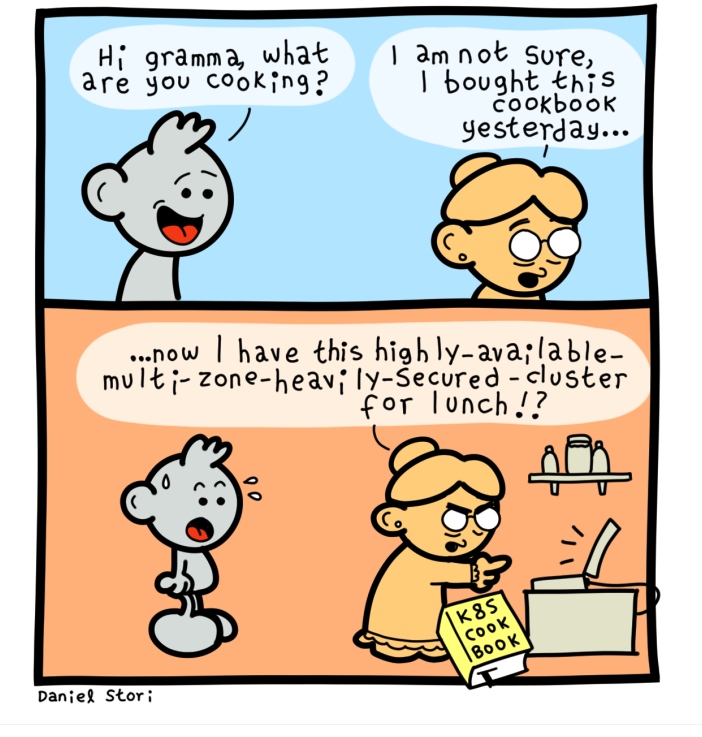.gif)
The cartoon above shows a man eating soup. As he lifts the spoon (A), it pulls a string (B), which flips a ladle (C), throwing a cracker (D) past a parrot (E). The startled parrot jumps, tipping over a cup (F), spilling water (G), which weighs down a string (H), pulling down a lighter (I) to ignite a firework (J), which launches a rocket (K) that pulls another string (L), finally activating a napkin (M) to wipe his mouth.
All of that… just to use a napkin.
Now imagine deploying a container with Kubernetes.
You don’t just run it. You define a Pod, which is managed by a Deployment, exposed by a Service, routed by an Ingress, connected through a ConfigMap, monitored by Prometheus, secured with Secrets, configured by Helm charts, deployed through GitOps, and logged with Fluentd. All of it, just to say: run this app and keep it alive.
This is the essence of a Rube Goldberg machine: solving a basic problem through the most complex and indirect path possible.
The Satisfying Complexity
Here’s the twist, it works.
Just like the Goldberg machine, Kubernetes is a joy to watch when it functions correctly. Autoscaling kicks in. Pods self-heal. Canary deployments roll out gracefully. Logs stream to dashboards. Alerts fire exactly when needed.
There’s a real sense of intellectual pleasure when all these moving parts work together in harmony. Complexity, in this case, becomes a kind of craft.
When It’s Too Much
But not all problems require this kind of machinery.
Using Kubernetes to host a blog, serve a static site, or deploy a small backend can be like buying a Ferrari to drive to the corner store. It works, sure. It’s impressive. But was it really the best way?
Smaller companies or simpler applications often find themselves buried in abstractions, debugging Ingresses, wrestling with Helm charts, or fighting a failing deployment that could have been avoided by… well, not using Kubernetes at all.
The tooling becomes the job. The simple gets complex. And the napkin never gets to your face.
When It’s Justified
To be clear, Kubernetes wasn’t built to solve simple problems. It was designed to tame complex, distributed systems; the kind of infrastructure that powers global apps, with thousands of services and unpredictable workloads.
In those contexts, the complexity is not only justified but it’s essential. Kubernetes brings structure, automation, and repeatability to what would otherwise be chaos. It’s a factory floor for modern software.
The challenge is knowing when that complexity is worth it.

The Point
Kubernetes is powerful. It’s flexible. And yes! it’s often absurdly complex.
That’s what makes it feel like a Rube Goldberg machine: elegant, excessive, and strangely beautiful when everything clicks.
But before you spin up your cluster, ask yourself:
Am I solving a problem, or just building something cool?
Sometimes, all you need is a napkin; not a parrot, rocket, and lighter.